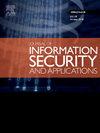Severity-based triage of cybersecurity incidents using kill chain attack graphs
IF 3.8
2区 计算机科学
Q2 COMPUTER SCIENCE, INFORMATION SYSTEMS
Journal of Information Security and Applications
Pub Date : 2025-01-16
DOI:10.1016/j.jisa.2024.103956
引用次数: 0
Abstract
Security teams process a vast number of security events. Their security analysts spend considerable time triaging cybersecurity alerts. Many alerts reveal incidents that must be handled first and escalated to the more experienced staff to allow appropriate responses according to their severity. The current state requires an automated approach, considering contextual relationships among security events, especially detected attack tactics and techniques. In this paper, we propose a new graph-based approach for incident triage. First, it generates a kill chain attack graph from host and network data. Second, it creates sequences of detected alerts that could represent ongoing multi-step cyber attacks and matches them with the attack graph. Last, it assigns severity levels to the created sequences of alerts according to the most advanced kill chain phases that were used and the criticality of assets. We implemented the approach using the MulVAL attack graph generator and generation rules for MITRE ATT&CK techniques. The evaluation was accomplished in a testbed where multi-step attack scenarios were executed. Classification of sequences of alerts based on computed match scores obtained 0.95 area under the receiver operating characteristic curve in a feasible time. Moreover, a threshold exists for classifying 80% of positive sequences correctly and only a small percentage of negative sequences wrongly. Therefore, the approach selects malicious sequences of alerts and significantly improves incident triage.
使用杀伤链攻击图对网络安全事件进行基于严重程度的分类
安全团队处理大量的安全事件。他们的安全分析师花费大量时间对网络安全警报进行分类。许多警报揭示了必须首先处理的事件,并将其升级到更有经验的员工,以便根据其严重程度做出适当的响应。当前状态需要一种自动化的方法,考虑安全事件之间的上下文关系,特别是检测到的攻击策略和技术。在本文中,我们提出了一种新的基于图的事故分类方法。首先,根据主机和网络数据生成杀伤链攻击图。其次,它创建检测到的警报序列,这些警报可以代表正在进行的多步骤网络攻击,并将它们与攻击图相匹配。最后,它根据所使用的最先进的杀伤链阶段和资产的临界性,为所创建的警报序列分配严重性级别。我们使用MulVAL攻击图生成器和MITRE攻击和CK技术的生成规则实现了该方法。评估是在执行多步骤攻击场景的测试平台中完成的。基于计算匹配分数的预警序列分类在可行时间内在接收者工作特征曲线下获得0.95的面积。此外,存在一个阈值,即80%的阳性序列正确分类,只有一小部分阴性序列错误分类。因此,该方法可以选择恶意警报序列,并显著改善事件分类。
本文章由计算机程序翻译,如有差异,请以英文原文为准。
求助全文
约1分钟内获得全文
求助全文
来源期刊

Journal of Information Security and Applications
Computer Science-Computer Networks and Communications
CiteScore
10.90
自引率
5.40%
发文量
206
审稿时长
56 days
期刊介绍:
Journal of Information Security and Applications (JISA) focuses on the original research and practice-driven applications with relevance to information security and applications. JISA provides a common linkage between a vibrant scientific and research community and industry professionals by offering a clear view on modern problems and challenges in information security, as well as identifying promising scientific and "best-practice" solutions. JISA issues offer a balance between original research work and innovative industrial approaches by internationally renowned information security experts and researchers.
 求助内容:
求助内容: 应助结果提醒方式:
应助结果提醒方式:


